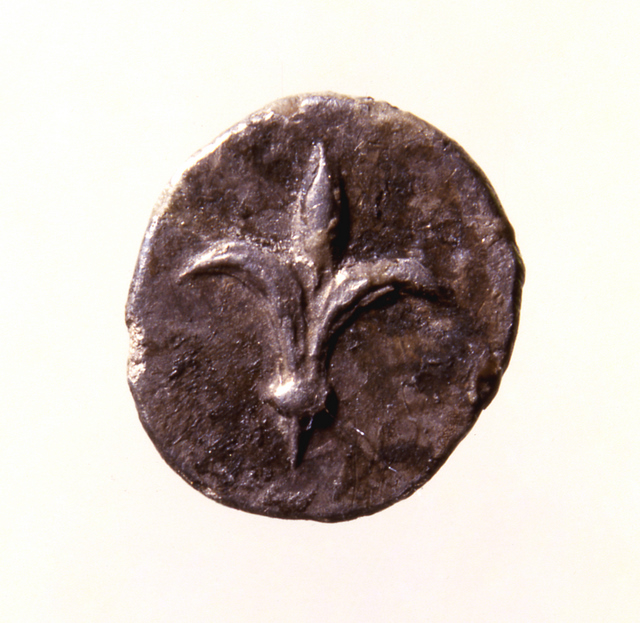Yehud Coin 1, 4th century BCE
A Coin with the Symbol of Israel
Date- 4th cent. BCE
Current Location- Israel Museum, Jerusalem, Israel
Language and Script- Aramaic, alphabetic
General Information-
• This minute silver coin, minted in Jerusalem in about 350 BC, is one of the earliest known Jewish coins, one of the artistic highlights of Jewish numismatics, and is the first extra-biblical instance of the common usage of ‘Judea’ to denote the Israelite province.
• On the obverse is shown a lily flower, or fleur-de-lys, which later became the French sign of royalty. Given the Latin name lilium candidum by biologists, it is a symbol of purity and was regarded in Ancient Israel as the most beautiful flower. In the words of the prophet Hosea, the lily was the national flower of Israel- “I will be like the dew for Israel; he shall blossom like the lily” (Hosea 14-6). It was referred to allegorically in the Song of Songs (2-1) and was often used in similes by later Hebrew poets. The white lily was a major ingredient in perfumes, no doubt was used in sacred incenses, and constituted a main type of spice for the ancients. Though not found in profusion in Israel today, we may assume that the lily was once common in all parts of the country, especially when we consider that there has been much botanical change in Israel resulting from climate change as well as much trade and population movement throughout the Levant. The use of the lily on this coin is apparently derived from the design that graced the capitals of the two main pillars that stood in front of the Temple, known as Jachin and Boaz. Following from its earlier use, the lily became a popular motif in Jewish art of the Second Temple Period, appearing on coins struck in Jerusalem during the second and first centuries BCE under Antiochus VII, John Hyrcanus I and Alexander Jannaeus.
• The reverse side bears an image of a bird. Zoologists cannot determine the exact species from the depiction, but have suggested that it is a falcon or hawk. The heraldic form of the bird is borrowed from contemporary coins of Asia Minor that depict other birds in a similar fashion. Near the bird’s head is the word ‘Yehud,’ “YHD,” in ancient Aramaic script. This expression had a twofold meaning, signifying both the name of the city Jerusalem as the capital (Aramaic ‘Birta’) of Judah and the province (Aramaic ‘Medinta’) itself. This assumption is based on the fact that at the time of the minting of this coin and during the previous few centuries “YHD” was the name of Jerusalem. In the Book of Chronicles (2 26-28), Amaziah king of Judah was buried with his fathers in the city of Judah, which must refer to Jerusalem since, as the capital, all the Judean kings were buried there. Although this refers to his burial in 769 BCE, Chronicles is a later edition of Israelite history, implying that the author knew of Jerusalem as “Yehudah,” or Judah. In addition to the local meaning, Yehud was the current name of the province of Judah during the fifth and fourth centuries BCE since Aramaic had already replaced Akkadian as the lingua franca of the Near East and which the current Persian Empire employed as well instead of its native tongue.
• A number of other small coins have been discovered from this time period with ‘YHD’ pressed into them. It seems that they were minted by a self-governing authority of the province of Judea because they are only found in small denominations. Since, in those times, the face value of coins was equivalent with the inherent value of the metal, small coins meant small denominations. And the Persian Empire could certainly have afforded to commission larger coins. Combining that information with the lack of Persian symbols on the coins gives a strong indication of great autonomy on the part of Judean authorities granted by the Persians – they could make their own money! These coins give us a good idea about the political status of Judea within the Persian Empire; it was one of the more respected provinces.





